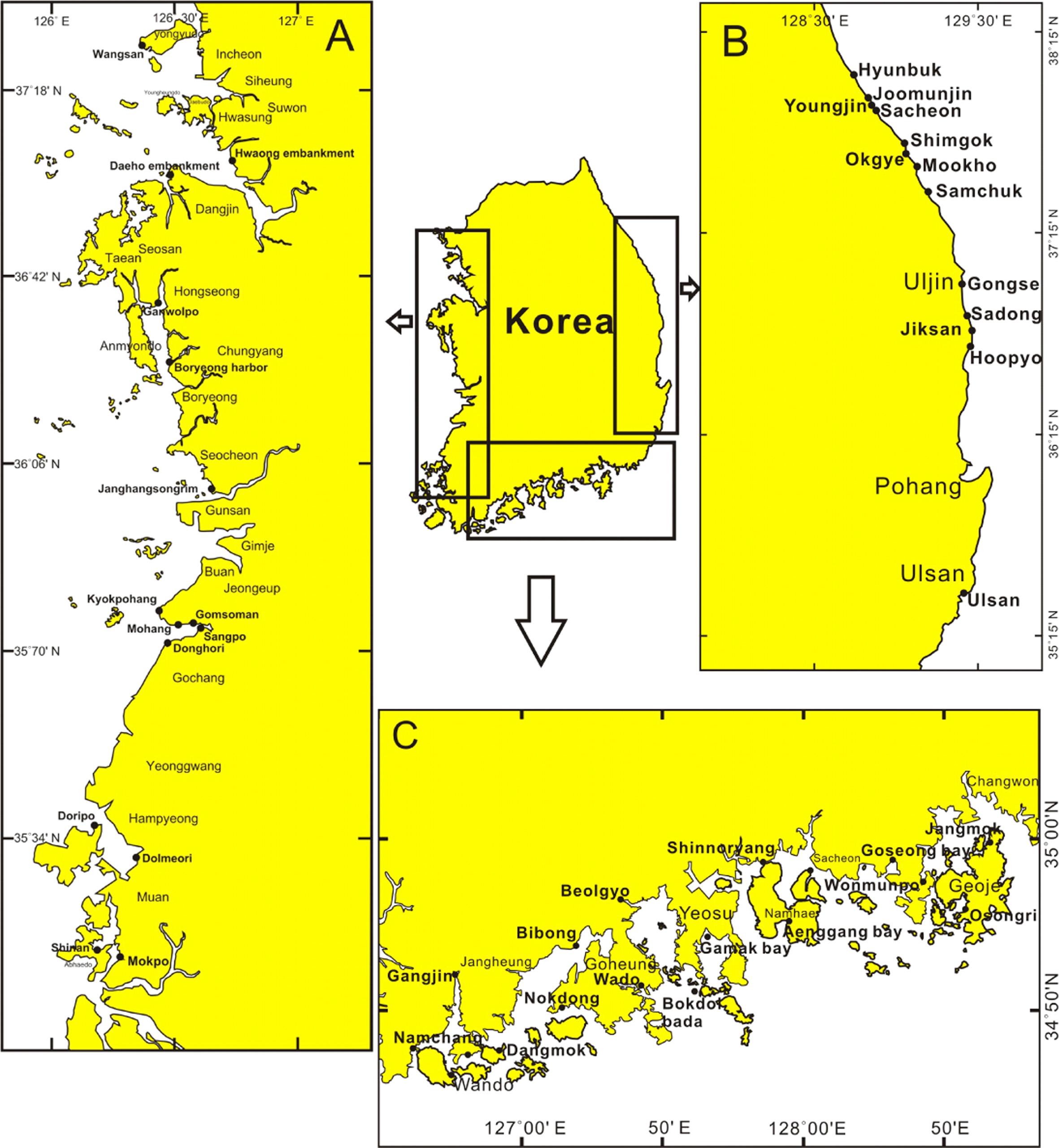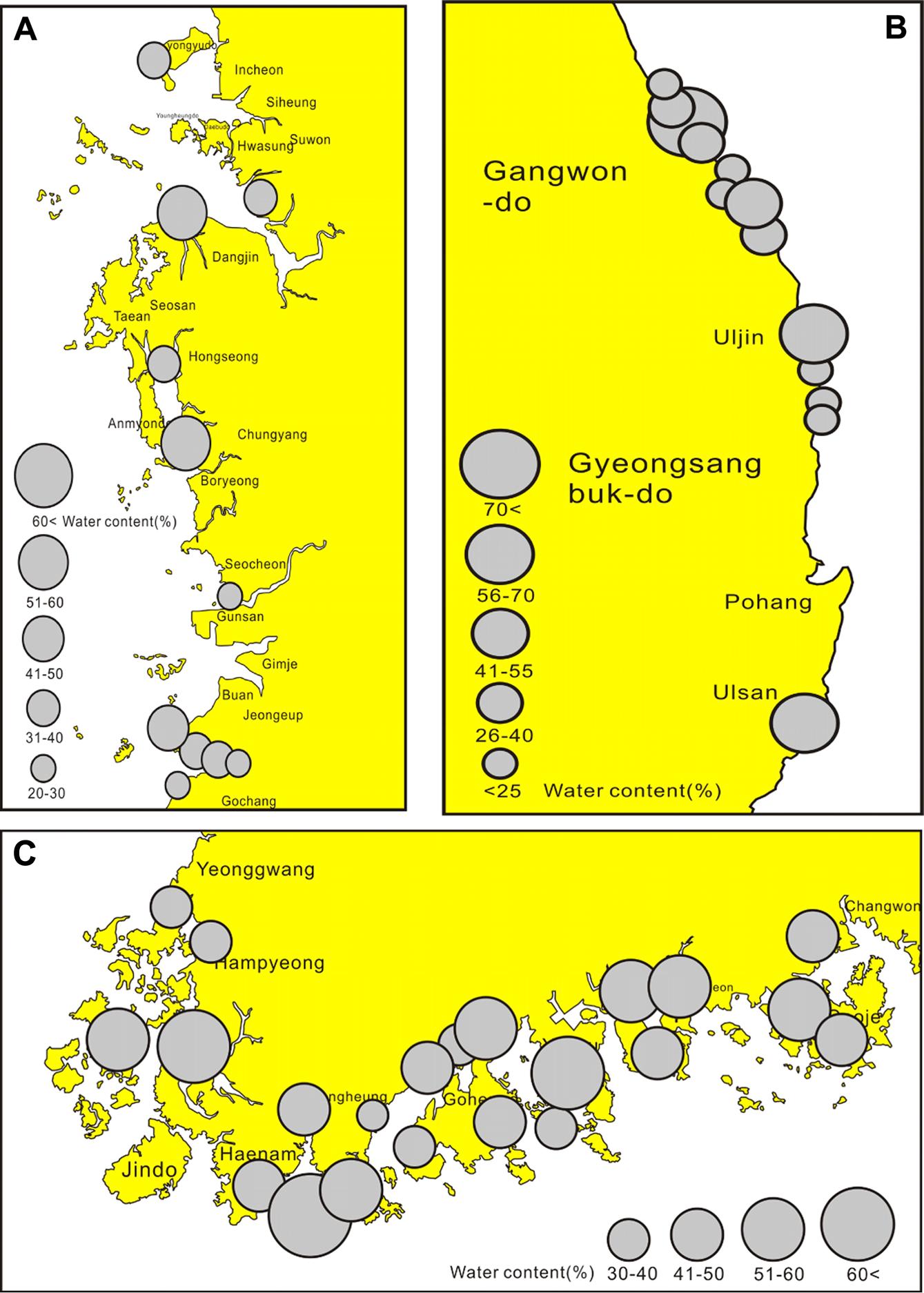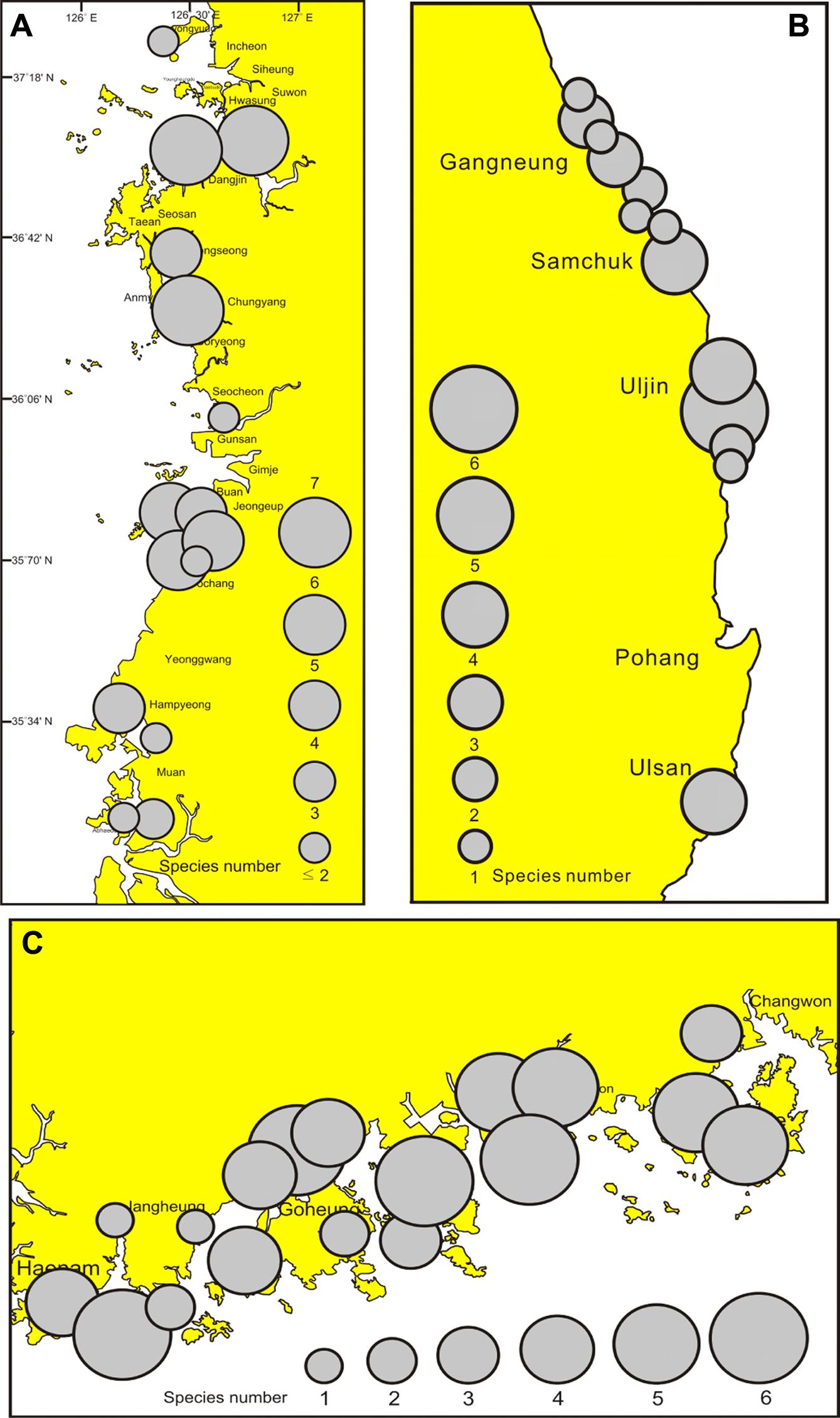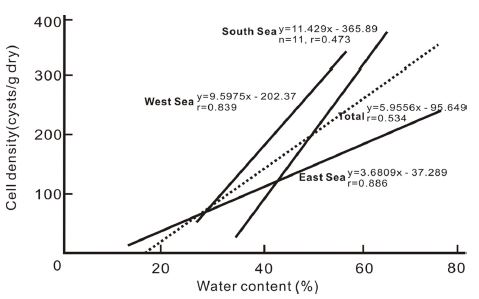
한국 해안선 주변해역의 표층퇴적물 중 현생 와편모조 시스트 군집의 출현특성
초록
한국 연안해역에 출현하는 와편모조 시스트 분포 특성을 파악하기 위하여 동해, 서해, 남해에 위치한 주요 항의 표층 퇴적물을 대상으로 현장조사를 실시하였다. 표층 퇴적물 0~2 cm를 채집하여 분석한 결과 와편모조 시스트는 총 4그룹 10속 30종이 출현하였다. 해역별로는 동해 3그룹 5속 13종, 서해 4그룹 11속 20종, 남해 3그룹 7속 22종이 출현하였고, Gonyaulacoid, Protoperidinioid, Gymnodinioid 및 Diplosalid 그룹이 각각 40.0%, 36.7%, 17.6% 그리고 6.7%를 차지하여, Gonyaulacoid와 Protoperidinioid 그룹이 76.7%를 차지하였다. 전체 출현종수는 30종이지만, 각 정점에서는 1~7종으로 낮았다. 시스트 현존량은 11~1,040 cysts g-dry-1의 범위로 동해 11~320 cysts g-dry-1, 서해 15~334 cysts g-dry-1, 남해 20~1,040 cysts g-dry-1의 범위로 출현하였다. 독립영양종의 비율은 동해, 서해 및 남해에서 각각 25.3%, 78.5%, 55.5%이었고, 종속영양종의 비는 동해, 서해 및 남해에서 각각 74.7%, 21.5%, 44.5%이었다. 우점종은 동해에서 Protoperidinium sp.(Brigantedinium sp), Gonyaulax scrippsae, Protoceratium reticulatum, Polykrikos schawartzii가, 서해는 G. scrippsae와 Lingulodinium polyedrum, Oblea acanthocysta, Protoperidinium minutum이었다. 그리고 남해는 L. polyedrum, Protoperidinium sp.(Brigantedinium sp), G. scrippsae, Protoperidinium conicum, Alexandrium catenella/tamarense로 나타났다. 이 중 P. reticulatum과 A. catenella/tamarense는 패류독화 원인종으로 모니터링이 필요한 종이다. 그리고 부영양화 지표종인 Polykrikos schwartzii의 시스트는 한국연안에서 처음 기록되었다. 결론적으로 한국 연안해역의 와편모조 시스트 분포는 해역의 환경특성에 따라 다르게 표현되고 있지만, 이 논문에서는 육상기점 표본에 한정되고 있어 객관적 생물해양학적 환경특성을 고찰하기에는 한계가 있었다.
Abstract
We carried out on the distributions of dinoflagellate cysts in the Korean coastal waters(KCW). We collected samlpes on the surface sediments of 46 ports located in the East, West and South Sea of Korean Peninsula. Thirty species of dinoflagellte cysts were identified belonging to 10 genera and 4 groups, Gonyaulacoid, Protoperidinioid, Gymnodinioid and Diplopsalid Group comprising 40.0%, 36.7%, 17.6% and 6.7%, respectively. The abundance of dinoflagellate cysts ranged from 11 to 1,040 cysts g-dry-1. Ranges of 15~334 cysts g-dry-1, 11~320 cysts g-dry-1 and 20~1,040 cysts g-dry-1 were showed in the West, East and South Sea, respectively. The ratio of autotrophic and hetertrophic species showed 78.5% vs 21.5% in West Sea, 25.3% vs 74.7% in East Sea, and 55.5% vs 44.5% in South Sea, respectively. In the West Sea, The dominant species were Gonyaulax scrippsae, Lingulodinium polyedrum, Oblea acanthocysta, Protoperidinium minutum in the West Sea, Protoperidinium spp, G. scrippsae, Protoceratium reticulatum, Polykrikos schawartzii in East Sea, and L. polyedrum, Protoperidinium sp(Brigantedinium sp), G. scrippsae, Protoperidinium conicum, Alexandrium catenella/tamarense in the South Sea. Protoperidinoid group, L. polyedrum, and G. scrippsae occurred in the eutrophication area of the KCW. P. reticulatum and A. catenella/tamarense known to shellfish poisoning species, should be monitored continuously. And cyst of Polykrikos schwartzii, eutrophication indicator species was firstly recorded in the KCW. The results of this study showed that the characteristics of dinoflagellate cyst distribution around the Korean waters are different according to the regional sea.
Keywords:
distribution, dinoflagellate cysts, surface sediments, Korean coastal waters, autotrophic and heterotrophic species, dominant species키워드:
분포, 와편모조 시스트, 표층되적물, KCW, 한국연안해역, 독립영양과 종속영양종, 우점종1. 서 론
해양식물플랑크톤 군집에서 와편모조류는 규조류 다음으로 종수 및 현존량이 높은 해양의 주요 기초생산자로서 현재 2,500여종이 알려진다(Taylor[1987]; Gomez[2012]). 와편모조류 영양세포는 표영 환경에서 핵분열에 의한 무성생식을 하지만, 서식환경이 나빠지면 접합자와 결합하는 유성생식으로 두 개의 종편모를 가지는 운동성 접합자(planozygote)를 형성한다. 운동성 접합자는 수일 후 휴면성 접합자(hypnozygote)로 스포로폴레닌이라는 아주 내구성의 강한 유기세포벽으로 운동성을 상실한 휴면포자(resting cyst), 즉 시스트(cyst)가 되어 퇴적층으로 침강하여 휴면한다. 휴면포자는 몇 주에서 몇 개월을 표층퇴적층에 있다가 서식환경이 좋아지면 수온, 빛 등 외부자극으로 발아하여(Anderson et al.[1983]), 2개의 종편모를 가진 운동성 감수모세포(planomeiocyte)로 표영환경에 가입되어 감수분열로 정상 영양세포가 된다(Matsuoka and Fukuyo[2000]). 그러나 일부 종은 운동성 접합자에서 직접 감수분열 하여 영양세포로 되돌아가는 등(Uchida et al.[1996]) 아직까지 많은 와편모조에서 휴면포자를 포함한 생활사가 명확하지 않다(Matsuoka and Fukuyo[2000]). 현재 와편모조류의 10% 전후인 200여종만이 시스트를 형성하는 것으로 알려지고 있다(Bravo and Figueroa[2014]).
와편모조류의 영양방식은 종에 따라 독립영양, 종속영양, 그리고 혼합영양까지 종에 따라 매우 다양할 뿐만 아니라 생리·생태적으로 다른 미세조류와는 많은 차이를 보이는 가장 특이한 특성을 보이는 생물군이다(Gains and Elbrachter[1987]; Inoue[2007]). 이러한 영양방식은 주로 오염되지 않은 깨끗한 서식환경에서 독립영양종이 우세한 반면, 연안/내만의 부영양화 등의 조건에서 미소먹이생물 서식이 좋은 해역은 종속영양종이 우세하다는 전제 조건을 기본으로 퇴적층 시스트의 연직분포와 퇴적속도가 계산되면, 퇴적시기에 따른 해역의 유기오염 진행과정을 추정할 수 있는 지표로도 많이 이용된다(Dale et al.[1999]; Matsuoka[1999]; Dale[2001,2009]; Ismael et al.[2014]). 또한 시스트는 유해/유독적조를 발생시키는 종자군(seed population) 역할을 하여, 매년 같은 시기와 장소에서 유해적조가 발생하는 것에 대해 중요한 단서를 제공하기도 하고(Yoon and Shin[2014]), 견고한 세포벽으로 시스트가 보호되고 있어 많은 종이 화석으로 출토되기에 고해양환경을 파악하기 위한 좋은 지표생물로 사용되고 있을 뿐만 아니라 표영환경의 누적지표로서 해역의 생물해양학적 환경특성을 파악하는 중요한 지표 등 다양한 분야에서 광범위하게 사용된다(Yoon and Shin[2014]).
국내 와편모조 시스트에 대한 연구는 1980년대 말부터 시작 되어(Kim et al.[1990]; Lee and Yoo[1991]), 2000년 이후 본격적으로 연구되었다(Yoon and Shin[2013]). 그러나 시스트 연구 대부분은 남해에 한정되어 있으며(Lee and Matsuoka[1996]; Lee et al.[1998]; Cho et al.[2003]; Park et al.[2005]; Shin et al.[2007a,b]; Kim et al.[2009]; Pospelova and Kim[2010]; Shin et al.[2011] etc), 일부 서해 및 황해(Cho and Matsuoka[2001]; Park et al.[2004]; Hwang et al.[2009, 2011]), 그리고 제주도 및 동중국해(Cho and Matsuoka[2001]; Cho et al.[2004]; Park et al.[2016])를 대상으로 한 연구보고가 있을 뿐, 한국 연안의 전해역 및 동해를 대상으로 한 연구(Yoon[2017)는 거의 찾아볼 수 없다.
이 연구는 환경특성을 달리하는 동·서·남해의 해안선 주변해역의 표층퇴적물 중 와편모조 시스트 군집의 분포특성을 파악하여, 국내 각 해역별 생물해양학적 특성 파악과 함께, 해양환경 및 해양생태계 보전, 그리고 해역의 이용과 관리를 위한 기초자료 제공을 목적으로 실시하였다.
2. 재료 및 방법
현장표본채집은 2012년 6월부터 2015년 10월까지 한국의 서해, 동해 및 남해의 해안선을 따라 표층퇴적물을 채집하였지만, 모래나 자갈퇴적상의 많은 정점에서는 퇴적물 시료를 채집을 할 수 없었지만, 서해 15개 정점, 동해 13개 정점 그리고 남해 18개 정점에서 퇴적물 시료를 채집할 수 있었다(Fig. 1). 표층퇴적물 채집은 소형 Ekman-Birge 채니기(Hydro-Bios, D-2300 KIEL)를 이용하였으며, 채집된 퇴적물은 플라스틱 시약스푼으로 0~2 cm의 표층퇴적물을 플라스틱 용기에 밀폐할 수 있도록 채집하여, 아이스박스를 이용하여 실험실로 운반하였다. 하지만 서해 및 동해의 일부정점은 노출된 해저의 수로부에서 직접 시약스푼으로 퇴적물을 채집하기도 하였다.
채집된 표층퇴적물은 산과 알카리시약을 이용하여 중탕과 세척 등의 수회 반복으로 퇴적물 중의 염분, 미세조류, 방산충, 규산질, 유기물 등을 제거하고 초음파분쇄기(Bandelin Electronic, UW2070)로 분쇄하여 mesh size가 125 μm와 20 μm 체를 중첩시켜 20 μm 체에 농축한 다음 미세사질를 제거하여 10 mL로 맞추어 현미경관찰용 시료로 제공하였다(Yoon and Shin[2014]). 검경 농축시료 1 mL를 Sedgwick-Rafter chamber에 취하여 DIC장치의 광학현미경(Olymps BX50/Nikon Eclipse 80i)을 이용하여 100X~400X 배율에서 시스트 종의 동정과 계수를 실시하였다. 종의 동정은 Matsuoka and Fukuyo[2000] 및 관련 논문을 참고하였으며, 시스트의 현존량은 단위 건중량당 세포수(cysts g-dry-1)로 표시하였다. 그리고 함수율은 퇴적물의 건중량과 습중량의 비로 측정하였다.
그리고 생물명은 플랑크톤명칭을 우선적으로 적용하였고, 1% 이상의 우점률을 보이는 우점종과 영양방법 차이에 따른 분류군의 출현세포밀도를 SPSS 응용통계 프로그램으로 주성분분석(PCA)을 실시한 결과를 이용하여 해역별 생물해양학적 환경특성을 고찰하였다. 생물종을 이용한 주성분분석 계산은 누적기여율 70%를 기준으로 하였으며(Yoon[1989]), 해석은 제1 및 제2주성분만을 사용하였다.
3. 결 과
3.1 함수율
함수율은 퇴적물에 포함된 수분의 함량으로 미세한 퇴적입자에서 높고, 조립한 퇴적입자에서 낮은 값을 나타낸다. 의 한국 해안선 주변 표층퇴적물의 함수율은 동해 후포항에서 12.8%로 낮았고, 영진항에서 75.0%로 높아 해역 및 정점에 따른 차이가 큰 특징을 보였다. 즉 서해는 26.5~56.4% 범위에서 39.8±11.3%(평균 ± 표준편차로 이하 동일하게 표현)의 변동 폭을 보였고, 동해는 12.8~75.0% 범위에서 34.2±21.1%의 변동 폭을, 그리고 남해는 38.4~64.7% 범위에서 49.2±7.7%의 변동 폭으로 동해, 서해, 남해 순으로 함수율이 높았고, 정점에 변동 차이는 남해, 서해, 동해 순으로 크게 나타났다. 세부적으로 서해는 장항 송림에서 낮고 목포에서 높지만, 보령, 신안, 대호방조제 등을 제외하면 전체적으로 낮은 값을 보였다(Fig. 2A). 동해는 옥계, 후포, 직산 및 사동항에서 20% 이하의 함수율을 보인 반면, 영진, 공세, 울산항에서는 60% 이상의 높은 함수율을 보였다(Fig. 2B). 남해는 득량만 수문항에서 40% 이하의 함수율을 보이지만 많은 정점에서 50% 이상의 함수율을 보였다. 특히 완도항과 가만막 북부 해역에서는 60% 이상의 함수율을 보였다(Fig. 2C).
3.2 와편모조 시스트 군집
한국 연안 해안선 주변해역의 표층퇴적물에서 관찰된 와편모조 시스트는 4그룹에 거쳐 10속 30종이었다. 즉 독립영양종 Gonyaulacoid 그룹이 12종으로 40.0%의 높은 출현 점유률, 다음은 종속영양종 Protoperidinioid 그룹이 11종으로 36.7%, 독립 및 종속영양종을 포함하는 Gymnodinioid 그룹이 5종으로 16.6% 그리고 종속영양종인 Diplopsalid 그룹이 2종으로 6.7%의 출현 점유율를 보였다(Table 1 및 Fig. 3A). 영양방법으로는 독립영양종이 8속 16종으로 53.3%, 종속영양종은 4속 14종으로 46.7%로 거의 비슷한 출현비를 보이나, 독립영양종 조성비가 다소 높았다(Table 1).

Species composition of dinoflagellate cyst assemblages on the surface sediments in the total (A), West Sea (B), East Sea (C) and South Sea (D) of the KCW.
해역별은 서해가 전체 4그룹 11속 20종에서 Gonyaulacoid가 9종 45.0%의 점유률을, Protoperidinioid가 6종 30.0%, Gymnodinioid가 4종 20.0%, 그리고 Diplopsalid가 1종 5.0%의 점유률을 보였고(Fig. 3B). 동해는 전체 3그룹 5속 13종에서 Protopeidinioid가 6종 46.2%, Gonyaulacoid가 4종 30.7%, 그리고 Gymnodinioid가 3종 23.1%(Fig. 3C). 그리고 남해는 전체 3그룹 7속 22종에서 Gonyaulacoid가 12종 54.5%, Protopeidinioid가 8종 36.4% 그리고 Diplopsalid가 2종 9.1%의 출현 점유율을 보였다(Fig. 3D). 즉 연안해안선 주변해역에서 대표적인 독립영양종인 Gonyaulacoid가 남해, 서해 및 동해의 순으로 출현종이 다양성이 점차 감소하는 특성을 보이지만, 종속영양종인 Protoperidinioid는 해역의 조석차를 반영하는 양상으로 동해, 남해 및 서해 순으로 조석차에 의해 조석차가 작은 해역에서 다양성이 높고, 큰 곳에서 다양성이 낮았다. 그리고 무각 와편모조류 Gymnodinoid는 동해와 서해에서 비교적 다양하게 출현하였지만, 남해는 출현이 확인되지 않았다(Fig. 3).
출현종의 공간분포는 전체 종수가 30종이지만, 서해가 18종, 동해가 13종, 그리고 남해가 22종으로 해역에 따라 다양한 해양환경 특성을 보이는 남해에서 높았고, 조석차가 작고 단조로운 해안선을 가지는 동해에서 낮았다. 그리고 해역에 관계없이 각 정점별로는 1 ~ 7종이 출현하였다. 즉 서해는 사질퇴적상을 나타낸 함평 돌머리해안에서 1종이 출현하였고, 화옹방조제, 대화방조제, 보령항 등에서는 각 7종이 출현하였다(Fig. 4A). 동해는 대부분 방파제에 의해 해수흐름이 제한된 포구에서 퇴적물을 채집되었고, 현북, 영진, 옥계, 묵호 및 후포항은 사질퇴적상으로 각 1종이 출현하였으며 사동항에서 6종이 출현하여, 전체적으로는 서해나 남해보다 단순한 종출현 특성을 보였다(Fig. 4B). 남해는 서부의 도암만 내만역과 장흥회진에서 1종이 출현하였고, 완도항, 가막만, 앵강만 및 장흥 수문리에서는 각 6종이 출현하였으며, 전체적으로는 서해 및 동해에 비해 다양한 종출현 특성을 보였다(Fig. 4C).
해안선 주변해역의 표층퇴적물에 출현한 와편모조 시스트의 현존량은 동해 사질해안에서 11 cysts g-dry-1의 세포밀도로 낮았고, 남해 가막만에서 1,040 cysts g-dry-1로 높아, 해역별 차이는 약 100배 이상이었다. 전체적으로 사질퇴적물로 낮은 출현종을 보인 정점에서 낮았고, 많은 종이 출현한 정점에서 높은 세포밀도를 보였다(Fig. 5). 그리고 와편모조류는 영양방식에 의해 독립영양종과 종속영양종 시스트를 구분하면, 한국 연안 해안선 주변해역에서는 서해와 남해에서 독립영양종 조성비가 각각 78.5%와 55.5%로 높았고, 동해는 종속영양비가 74.7%로 서해와는 반대 양상을 나타내었다(Fig. 5).
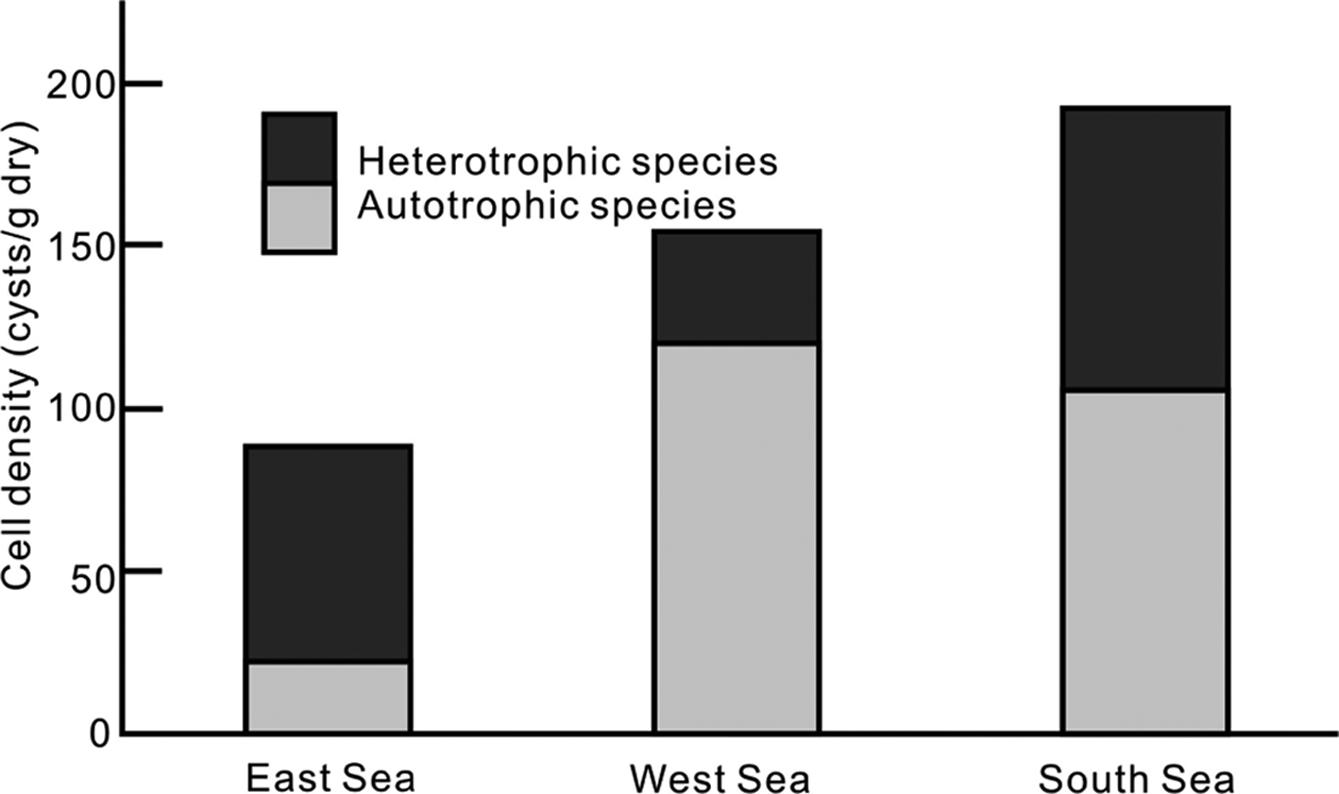
Variation of mean cell density of dinoflagellate cysts including autotrophic and heterotrophic species in the KCW.
세포밀도는 서해가 15~334 cysts g-dry-1 범위에서 154.7±113.0 cysts g-dry-1의 변동 폭으로 한 종이 출현한 함평 돌머리해안에서 15 cysts g-dry-1의 낮은 값을 보인 것에 반해, 상대적으로 다양한 종출현을 보인 화옹방조제, 대호방조제 및 보령항에서 300 cysts g-dry-1 이상 높은 세포밀도를 보였다(Fig. 6A). 또한 서해의 남부인 함평만 등 사질퇴적물에서 종속영양종의 조성비가 높았고, 기타 서해 중부 및 강화도 해역에서는 독립영양종의 조성비가 높은 특징을 보였다(Fig. 6A). 동해는 11~320 cysts g-dry-1 범위에서 88.5±87.7 cysts g-dry-1의 변동 폭으로 옥계, 삼척 및 후포항은 20 cysts g-dry-1 이하로 낮은 농도를 보였고, 영진항에서 cysts g-dry-1로 높은 세포밀도를 보였다(Fig. 6B). 또한 동해는 주문진과 직산항에서 독립영양종과 종속영양종 조성비가 유사한 것을 제외하면, 기타 모든 해역에서 종속영양종의 조성비가 높은 특성을 나타내었다(Fig. 6B). 그리고 남해는 20~1,040 cysts g-dry-1 범위에서 200.6 ± 226.6 cysts g-dry-1의 변동 폭으로 거제도 오송리, 고흥 와도, 득량만 서부해역인 오송리, 장흥회진 및 도암만 내만해역인 강진 등에서는 100 cysts g-dry-1 이하의 낮은 농도를 보였고, 가막만 북부에서 1,040 cysts g-dry-1의 높은 밀도를 보였다. 또한 경남 앵강만 내만역, 늑도 및 원문포에서 200 cysts g-dry-1 이상으로 상대적 높은 밀도를 나타내었다(Fig. 6C). 영양방식도 남해의 해남 남창, 장흥 회진과 중앙부 해역인 수문항, 벌교, 와도, 및 신노량에서 종속영양종의 조성비가 높았고, 강진, 당목항, 녹동항, 늑도 및 앵강만 등에서 독립영양종의 조성비가 높았지만, 해역인 규칙성은 발견되지 않았다(Fig. 6C).
한국 연안해역 표층퇴적물에 출현한 와편모조 시스트 중 해역별 정점평균으로 5.0%이상의 우점율을 보이는 우점종으로 정리하였다(Table 2). 서해는 독립영양종 Gonyaulacoid의 Gonyaulax scrippsae가 우점율 31.1%로 최우점하였고, Lingulodinium polyedrum, Gonyaulax sp.3, Protoceratium reticulatum 및 종속영양종 Diplopsalid의 Oblea acanthocysta와 Protoperidinioid의 Protoperidinium minutum이 우점율 10%이하를 보였다(Table 2). 동해는 종속영양종 Protoperidinium sp.2 (Brigantedinium sp.)가 우점율 53.4%로 극우점하였고, 차우점 종은 Protoperidinium sp.3 (Echinidinium sp.)가 우점율 18.9%를 나타내었다. 기타로는 독립영양종 G. scrippsae와 P. reticulatum 및 Gymnodinioid의 Polykrikos schwartzii가 우점율 10.0이하를 보였다(Table 2). 남해는 L. polyedrum이 우점율 26.3%로 최우점하였고, Protopeidinium sp.2와 G. scrippsae가 각 14.0%와 12.6%로 10% 이상의 우점율을, 기타 Alexandrium catenella/tamarense와 P. minutum이 동, 서해와는 달리 남해에서만 우점율 10% 이하로 출현하여 시스트의 우점종 조성에서도 동해, 서해 및 남해는 서로 다른 결과를 보였다(Table 2).
3.3 와편모조 시스트 분포 특성
와편모조 시스트 분포특성을 파악하기 위하여 1% 이상 우점율을 나타내는 출현종을 이용하여 주성분분석을 실시하였다. 분석결과 남해를 제외한 서해와 동해는 제3주성분까지 누적기여율이 약 70% 수준으로 주성분이 도출되었다. 그러나 남해는 제3주성분까지 54%의 누적기여율을 보였고, 제2주성분까지 누적기여율은 서해와 동해는 약 55% 이상이 도출되었지만, 남해는 42%로 다소 낮은 누적기여율을 보여, 복잡한 환경특성을 보였다(Table 3).

Eigen value, proportion and accumulative proportion by principal component analysis (PCA) on the dinoflagellate dominant species of the West, East and South Sea of the KCW
서해자료에서 도출된 주성분에 대한 인자부하량 분포를 보면 제1주성분은 종속영양종 시스트와 종속영양종인 Protoperidinium sp.5, Protoperidinium sp.2, Gonyaulax sp.4, Ph. hartmannii가 강한 양의 관계를, 제2주성분은 독립영양종 시스트(AD)와 독립영양종인 G. scrippsae, L. polyedrum, Py. steinii에 강한 양의 관계를 보이는 것에서(Fig. 7A), 제1주성분은 종속영양종의 출현을 특성지우는 특성값, 제2주성분은 독립영양종을 출현시키는 특성값으로 해석되었다. 즉 서해는 출현종과 세포밀도의 분포와는 달리 종속영양종이 독립 영양종보다 해역특성에 더 밀접한 관련성을 나타내었다. 동해는 제1주성분에 HD와 AD, 그리고 독립영양종, G. scrippsae, Pr. reticulatum 및 종속영양종, Protoperidinium sp.2, Protoperidinium sp.4와 강한 양의 관계를, 제2주성분은 종속영양종, Ph. hartmanii, Pt. minutum, Protoperidinium sp.5 및 독립영양종, Gonyaulax sp.2와 강한 양의 관계를 나타내는 것에서 서해와 같이 제1주성분은 독립영양종, 제2주성분은 종속영양종을 출현시키는 특성값으로 해석되었다(Fig. 7B). 남해는 제1주성분에 HD, AD, L. polyedrum과 Pt. conicum, Pt. pentagonum 그리고 Protoperidinium sp.2와 강한 양의 관계를, 제2주성분은 Pt, latissimum, Pt. claudicans, Gonyaulax sp.2와 강한 양의 관계로 동해와 유사하게 뚜렷한 경향성이 나타나지는 않았다(Fig. 7C).

Loading factor by PCA on the dominant species of dinoflagellate cyst assamblages of the West, East and South Sea of the KCW. (AD: Autotrophic dinoflagellates, HD: Heterotrophic dinoflagellates, Aca: Alexandrinium catenatum, Asp: Alexandrinium sp., Gdi: Gonyaulax digitalis, Gsri: Gonyaulax scrippsae, Gsp1: Gonyaulax sp.1, Gsp2L Gonyaulax sp.2, Gsp3: Gonyaulax sp.3, Gsp4: Gonyaulax sp.4, Gysp: Gymnodinium sp., Lpol: Lingulodinium polyedrum, Oaca: Oblea acanthocysta, Pblo: Protoperidinium minutum, Pcla: Protoperidinium claudicans, Pcon: Protoperidinium conicum, Phar: Pheopolykrikos hartmannii, Pla: Protoperidinium latissimum, Pmin: Protoperidinium minutum, Ppe: Protoperidinium pentagonum, Pre: Protoceratium reticulatum, Psch: Polykrikos schwartzii, Psp2: Protoperidinium sp.2 Psp4: Protoperidinium sp.3, Psp5: Protoperidinium sp.4, Pspp: Protoperidinium spp., Pyst: Pyrophacus steinii, Psp4: Protoperidinium sp.4, P.sp: Protoceratium sp.)
주성분분석의 득점분포로부터 서해는 출현종과 세포밀도에서 종속영양종에 지배되는 제1주성분에는 대호방조제, 보령, 격포항이 위치하였고, 독립영양종인 G. scrippsae가 우점하는 제2주성분에는 화옹/대호방조제가, 그리고 Gonyaulax sp.3, Pr. reticulatum, G. digitalis, Gymnodinium sp. 등에 독립영양종이 우세한 제1과 제2주성분의 교차부분에는 상포, 동호리, 곰소만, 모항, 왕산, 장항송림 및 간월포가 분포하였다(Fig. 8A). 동해는 G. scrippsae, Pr. reticulatum의 독립영양종과, Protoperidinium sp.2, Protoperidinium sp.4의 종속영양종에 지배되는 제1주성분에 영진항 및 현진항이 위치하였고, 종속영양종, Ph. hartmanii, Pt. minutum, Protoperidinium sp.5 및 독립영양종 Gonyaulax sp.2,에 지배되는 제2주성분에는 사동항이 분포하였다. 그리고 종속영양종, Pt. claudicans, Pt. conicum, P. schwartzii 및 독립영양종, Gonyaulax sp.1, Gymnodinium sp.에 의해 특징되는 제1 및 제2주성분의 교차부근에 울산, 공세, 현북, 후포, 심곡, 삼척, 주문진, 직산, 묵호 및 사천항 등 대부분 해역이 해당하였다(Fig. 8B). 남해는 독립영양종 출현비가 높고 세포밀도가 높으면서 G. scrippsae와 L. polyedrum이 우점하는 제1주성분의 양의 관계는 늑도, 앵강만, 가막만이 분포하였고, 제 2주성분에는 완도, 오송리, 수문동이 위치하였다. 기타 정점은 제1 및 제2주성분 모두에 음의 위치에 분포하였다(Fig. 8C).
4. 고 찰
한국연안의 해안선에 인접한 표층퇴적물에 출현한 와편모조 시스트는 30종으로 서해가 20종, 동해는 13종 그리고 남해는 22종으로 해양환경의 다양성에 따라 출현종도 다르게 나타났다. 그러나 한국 연안해역에서 연구된 50편이상의 문헌에 보고된 와편모조 시스트는 종 90종 이상(Yoon and Shin[2013])이었다. 출현종 수는 연구시기에 따라 와편모조 시스트 연구초기인 1990년대에는 10종 전후의 극히 제한된 종만 동정되었고(Kim et al.[1990]; Lee and Yoo[1991]), 최고 출현종수도 통영의 다양한 양식장 환경에서 광범위한 조사를 실시한 결과에서 47종이다(Pospelova and Kim[2010]). 문헌에서도 서해는 황해남부에서 41종(Cho and Matsuoka[2001]) 및 새만금연안 및 황해 동남부에서 23~32종(Park et al.[,2004]; Hwang et al.[2009, 2011]) , 동해 울산항 주변해역에서 33종(Yoon[in press]), 남해의 여자만, 봇돌바다 35종(Shin et al.[2011]), 거제연안, 가막만, 남서해역 등에서 33종 내외(Cho et al.[2003]; Park et al.[2005]; Shin et al.[2007a,b]; Park et al.[2008]), 그리고 제주 해안선 주변해역에서 30종(Park et al.[2016])에 비하면 다소 낮거나 유사한 결과이다. 다만 비교문헌의 정점수에 비해 이 연구의 정점 수는 매우 많다는 것을 고려하면 다소 낮은 값이며(Table 4), 각 해역별 출현종은 1~7종으로 낮았다. 이러한 낮은 출현종수는 해수수렴 및 확산에 의한 생물의 축적이나 확산보다 해안선 주변해역의 퇴적상이나 해수유동에 의한 결과로 추정할 수 있었다. 실제 고생물학 연구를 포함한 지구규모의 와편모조 시스트의 세포밀도는 해역에 따라 0~수십만 cysts g-dry-1의 범위로 매우 큰 변동을 한다(Head[1996]; Zonneveld et al.[2013]). 국내도 동중국해 북부에서 출현없음(Cho and Matsuoka[2001])에서 황해 중앙부의 20,828 cysts g-dry-1(Hwang et al.[2011])로 변동 폭은 크다. 그러나 이 연구에서는 1~1,040 cysts g-dry-1(평균 154 cysts g-dry-1)로 낮은 세포밀도를 보이는 것은 표본채집이 해안선에 인접하고 있어, 조석에 의한 해수유동이 강하게 작용하는 점과 서해 및 일부 남해를 제외하면 퇴적상이 사질 및 사니질이라는 점 등이 크게 작용하는 것으로 판단되었다. 즉 와편모조 시스트의 현존량은 퇴적물의 성질과 퇴적층의 퇴적속도에 의해 결정되며, 조류흐름 등으로 퇴적물의 유동이 많은 해역에 상대적으로 낮은 것이 알려진다(Dale[1983]; Anderson et al.[1995]; Joyce et al.[2005]). 한국연안도 내만이 발달된 남해에서 가장 많은 출현종과 세포밀도를 보였고, 개방특성을 보이는, 서해 및 동해에서 낮은 세포밀도를 보여 이러한 내용을 잘 반영하였다. 일예로 각 해역에서의 함수율과 시스트 세포밀도의 관계를 Fig. 9에 나타내었으며, 여기에서도 두 변수사이에 밀접한 관계를 알 수 있으며, 해역에 따라 기울기에서 많은 차이를 나타내는 것을 알 수 있었다.

Records of the species number, abundance, and dominant species of dinoflagellta cysts assemblages around the KCW
산업발전에 의한 해역의 부영양화과정을 추적하는 한 가지 방법으로 와편모조 시스트의 독립영양종과 종속영양종의 세포밀도 비율을 이용하기도 한다(Dale et al.[1999]; Matsuoka[1999]; Dale[2001, 2009]; Ismael et al.[2014]). 그러나 이 방법은 표층퇴적물의 교란이 심하거나 출현종의 세포밀도가 낮을 때에는 유의적인 결과를 도출하기 어렵다(Park et al.[2016]). 그러나 한국연안의 해역별 와편모조 시스트 군집에서 우점종을 이용하여 고찰하며, 서해는 독립영양종 Gonyaulax scrippsae 및 Lingulodinium polyedrum이 우점하였고, 동해는 종속영양종 Protoperidinium Group과 종속영양 G. scrippsae, 그리고 남해는 서해와 동일하게 독립영양종 G. scrippsae, L. polyedrum에 의해 우점되었다. 이러한 결과는 한국 삼면의 해역에서 동해가 환경오염 문제에 노출되어 있고, 서해와 남해는 아직 양호한 환경조건을 나타내고 있는 것으로도 해석할 수 있다. 이러한 결과는 표본 채집의 서해 및 남해는 항만 및 내만의 연안부에서 이루어지는 것에 반해, 동해는 해역특성으로 퇴적물 표본이 각 포구의 해수가 수렴하는 위치에서만 채집이 가능하기 때문에 나타난 현상이라 할 수 있다.
각 우점종의 종 특성은 Gonyaulax scrippsae는 남해, 서해 그리고 동중국해에 우점한다(Cho and Matsuoka[2001]; Cho et al.[2003], 2004; Kim et al.[2005]; Park et al.[2005, 2008]; Hwang et al.[2011]). 즉 Gonyaulax 속 시스트는 남해(Lee and Matsuoka[1996]; Park et al.[2005]) 등 쓰시마난류의 영향을 강하게 받는 해역에서 우점한다(Lee and Matsuoka[1996]; Shin et al.[2007a]). 또한 동해와 남해의 일부해역에서 우점한 Protoperidinioid는 진해-마산만(Lee and Yoo[1991]; Lee et al.[1998])과 같이 부영양화된 해역에 우점하지만(Pospelova and Kim [2010]; Shin et al.[2011]), 동·서·남해에서 우점한 Protoperidinium spp.(Brigantedinium spp.)는 특정 수온, 염분 및 영양염류 등의 환경요인과 인과관계 없이 일반적인 해역에서 우점하는 것이 알려진다(Shin et al.[2007b]; Zonneveld et al.[2013]). 그리고 동해에 우점 출현한 Polykrikos schwartzii는 전 세계적으로 부영양화 해역에 우점하는 종으로(Pospelova et al.[2002]; Shin et al.[2010]). 부영양화경의 지표종으로 이용된다(Matsuoka et al.[2003]). 그러나 아직 국내에서는 시스트로 처음 기록되는 종이다(Shin et al.[2010]). 서해와 남해에 우점 출현한 Lingulodiniuim polyedrum은 아직 국내에 우점종 출현은 보고되지 않지만 연안에서 일반적으로 출현하는 시스트 종이다. L. polyedrum 역시 용승해역이나 부영양화의 지표종으로 이용된다(Pospelova et al.[2002]). 그리고 서해와 남해에 우점 출현한 Protoceratium reticulatum은 yessotoxin(YTX)과 그 유도체를 생산하는 종으로(Satake et al., 1999; Hwang, 2009), 비교적 개방해역에 높은 세포밀도를 보이지만(Wilpshaar and Leereveld[1994]), 이 연구에서는 내만에서 우점 출현하였다. 지구규모에서 관범위하에 분포하는 마비성 패류독화 원인종인 Alexandrium 속은 서해의 새만금해역(Park et al.[2004])과 황해 중앙부 해역(Hwang et al.[2011]), 그리고 남해의 중앙부해역(Cho et al.[2003]; Shin et al.[2011])과 남서해해역(Shin et al.[2007b])에서 우점 출현하고, 특히 남해 중앙부에 특이적으로 출현하면서(Shin et al.[2011]), 초봄 국내 진주담치 및 굴 양식장 등에 패독을 발생시키는 종으로 지속적인 모니터링을 통한 출현동태 파악이 필요한 종이다(Kim et al.[2017]).
한국 연안해역에서 처음으로 광역적인 와편모조 시스트 연구를 시도한 결과로서 표층퇴적물의 시스트 분포는 해역의 표영환경 누적지표로서 동·서·남해의 해역환경특성을 반영하는 분포를 하는 것으로 판단되었다. 그러나 해역환경특성으로 서해와 남해는 연안정점이라도 거대한 내만해역 또는 외해로 다소 개방된 특성을 보이지만, 원래 개방된 특성을 보이는 동해는 소규모 어항의 극소적인 부분에서만 세립퇴적물의 시스트 표본을 채집할 수 있어, 동해의 객관적 해역특성을 파악하는데 한계를 가진다고 할 수 있다. 이러한 문제를 포함하여 앞으로 더 내실 있는 광역적 조사에 의한 연구결과가 요구된다.
Acknowledgments
이 논문은 2013년도 정부(교육과학기술부)의 재원으로 한국연구재단의 지원을 받아 수행된 기초연구사업(No. 2013005394) 결과이다.
References
- Anderson, D.M., Chisholm, S.W., and Watras, C.J., (1983), “Importance of life cycle events in population dynamics of Gonyaulax tamarensis”, Mar. Biol, 76, p179-189.
- Anderson, D.M., Fukuyo, Y., and Matsuoka, K., (1995), Cyst methodologies, In Hallegraeff, G.M., Anderson, D.M., and Cembella, A.D. (eds.), Manual on Harmful Marine Microalgae, IOC Manuals and Guides, Vol. 33, Unesco, Paris, p229-245.
-
Bravo, I., and Figueroa, R.I., (2014), “Towards an ecological understanding of dinoflagellate cyst functions”, Microorganisms, 2, p11-32.
[https://doi.org/10.3390/microorganisms2010011]

- Cho, H.J., Lee, J.B., and Moon, C.H., (2004), “Dinoflagellate cyst distribution in the surface sediments from the East China Sea around Jeju island”, Korean J. Environ. Biol, 22, p192-199.
-
Cho, H.J., Kim, C.H., Moon, C.H., and Matsuoka, K., (2003), “Dinoflagellate cysts in recent sediments from the Southern coastal waters of Korea”, Bot. Mar, 46, p332-337.
[https://doi.org/10.1515/bot.2003.030]

-
Cho, H.J., and Matsuoka, K., (2001), “Distribution of dinoflagellate cysts in surface sediments from the Yellow Sea and East China Sea”, Mar. Micropal, 42, p103-123.
[https://doi.org/10.1016/s0377-8398(01)00016-0]

- Dale, B., (1983), “Dinoflagellate resting cysts: ‘Benthic plankton’, in Fryxell, G.A. (ed.), Survival Strategies of the Algae, Cambridge Univ. Press, Cambridge, p69-136.
-
Dale, B., (2001), “Marine dinoflagellate cysts as indicators of eutrophication and industrial pollution: A discussion”, Sci. Total Environ, 264, p235-240.
[https://doi.org/10.1016/s0048-9697(00)00719-1]

-
Dale, B., (2009), “Eutrophication signals in the sedimentary record of dinoflagellate cysts in coastal waters”, J. Sea Res, 61, p103-113.
[https://doi.org/10.1016/j.seares.2008.06.007]

-
Dale, B., Thorsen, T.A., and Fjellsa, A., (1999), “Dinoflagellate cysts as indicators of cultural eutrophication in the Oslofjord, Norway”, Est. Coast. Shelf Sci, 48, p371-382.
[https://doi.org/10.1006/ecss.1999.0427]

- Gains, G., and Elbrachter, M., (1987), “Heterotrophic nutrition”, In Taylor, F.J.R. (ed), The Biology of Dinoflagellates, Blackwell Scientific Publications, Oxford, p224-268.
- Gomez, F., (2012), “A checklist and classification of living dinoflagellates (Dinoflagellata, Alveolata)”, CICIMAR Oceanides, 27, p65-140.
- Head, M., (1996), “Modern dinoflagellate cysts and their biological affinities”, Palynol.: principles and applications, 3, p1197-1248.
-
Hwang, C.H., Heo, S., and Kim, C.H., (2009), “Horizontal distribution of dinoflagellate resting cysts in sediments from the Southeastern Yellow Sea”, J. Korean Fish. Soc, 42, p68-72.
[https://doi.org/10.5657/kfas.2009.42.1.068]

-
Hwang, C.-H., Kim, K.-Y., Lee, Y., and Kim, C.-H., (2011), “Spatial distribution of dinoflagellate resting cysts in Yellow Sea surface sediments”, Algae, 26, p41-50.
[https://doi.org/10.4490/algae.2011.26.1.041]

- Inoue, I., (2007), The Natural History of Algae (2nd eds), Perspective of Three Million Years Evolution of Algae, Earth and Environment, Tokai Univ. Press, Tokyo, 643.
- Ismael, A., El-Masry, E., and Khadr, A., (2014), “Dnoflagellate [cyst][S1] as signals for eutrophication in the eastern harbour of Alexandria-Egypt”, Indian J. Geo-Mar. Sci, 43, p365-371.
-
Joyce, L.B., Pitcher, G.C., du Randt, A., Monteiro, P.M.S., (2005), “Dinoflagellate cysts from surface sediments of Saldanha Bay, South Africa: an indication of the potential risk of harmful algal blooms”, Harmful Algae, 4, p309-318.
[https://doi.org/10.1016/j.hal.2004.08.001]

- Kang, Y.J., Ko, T.H., Lee, J.A., Lee, J.-B., and Chung, I.K., (1999), “The community dynamics of phytoplankton and distribution of dinoflagellate cysts in Tongyoung Bay, Korea”, Algae, 14, p43-54.
- Kim, E.S., Li, Z., Oh, S.J., Yoon, Y.H., and Shin, H.H., (2017), “Morphological identification of Alexandrium species (Dinophyceae) from Jinhae-Masan Bay, Korea”, Ocean Sci. J, 52, in press.
- Kim, H.-J., Moon, C.-H., and Cho, H.-J., (2005), “Spacial-temporal characteristics of dinoflagellate cyst distribution in sediments of Busan harbor”, 「The Sea」J. Korean Soc. Oceanogr, 10, p196-203.
- Kim, H.G., Park, J.S., and Lee, S.G., (1990), “Coastal algal blooms caused by the cyst-forming dinoflagellates”, J. Korean Fish. Soc, 23, p468-474.
-
Kim, S.Y., Moon, C.H., Cho, H.J., and Lim, D.I., (2009), “Dinoflagellate cysts in coastal sediments as indicators of eutrophication: A case of Kwangyang bay, South Sea of Korea”, Est. Coasts, 32, p1225-1233.
[https://doi.org/10.1007/s12237-009-9212-6]

- Lee, J.B., Kim, D.Y., and Lee, J.A., (1998), “Community dynamic and distribution of dinoflagellates and their cysts in Masan-Chinhae Bay, Korea”, J. Fish. Sci. Tech, 1, p283-292.
- Lee, J.B., and Matsuoka, K., (1996), Dinoflagellate cysts in surface sediments of southern Korean waters, In Yasumoto, T., Oshima, Y., and Fukuyo, Y. (eds.), Harmful and Toxic Algal Blooms, IOC of Unesco, p173-176.
- Lee, J.B., and Yoo, K.I., (1991), “Distribution of dinoflagellate cysts in Masan Bay, Korea”, J. Oceanogr. Soc. Korea, 26, p304-312.
- Lee, M.H., Lee, J.B., Lee, J.A., and Park, J.G., (1999), “Community structure of flagellates and dynamics of resting cysts in Kamak bay, Korea”, Algae, 14, p255-266.
-
Matsuoka, K., (1999), “Eutrophication process recorded in dinoflagellate cyst assemblages - a case of Yokohama Port, Tokyo Bay, Japan”, Sci. Total Environ, 231, p17-35.
[https://doi.org/10.1016/s0048-9697(99)00087-x]

- Matsuoka, K., and Fukuyo, Y., (2000), Technical guide for modern diniflagellate cyst study, WESTPAC-HAB/WESTPAC/IOC, 29.
-
Matsuoka, K., Joyce, L.B., Kotani, Y., and Matsuyama, Y., (2003), “Modern dinoflagellate cysts in hypertrophic coastal waters of Tokyo bay, Japan”, J. Plankton Res, 25, p1461-1470.
[https://doi.org/10.1093/plankt/fbg111]

-
Park, B., Kim, Y., and Yoon, Y.H., (2016), “Distribution of dinoflagellate cysts in surface sediments of the coastal areas around Jeju Island, Korea”, J. Korean Soc. Mar. Environ. Energy, 19, p310-321.
[https://doi.org/10.7846/jkosmee.2016.19.4.310]

-
Park, K.-H., Kim, K.-Y., Kim, C.H., and Kim, H.G., (2004), “Spatio-temporal distribution of dinoflagellate resting cysts at the Saemangeum Area”, J. Korean Fish, 37, p202-208.
[https://doi.org/10.5657/kfas.2004.37.3.202]

-
Park, J.S., and Yoon, Y.H., (2003), “Marine environmental characteristics by distribution of dinoflagellate cysts in the Southwestern coastal waters of Korea. 1. Spatio-temporal distribution of dinoflagellate cysts in Gamak Bay”, J. Korean Fish, 36, p151-156.
[https://doi.org/10.5657/kfas.2003.36.2.151]

-
Park, J.S., Yoon, Y.H., Noh, I.H., Soh, H.Y., and Shin, H.H., (2008), “The marine environment and dinoflagellates cysts in the Southwestern Sea of Korea”, Algae, 23, p135-140.
[https://doi.org/10.4490/algae.2008.23.2.135]

- Park, J.S., Yoon, Y.H., Noh, I.H., and Soh, H.Y., (2005), “A study of organic matter and dinoflagellate cyst on surface sediments in the central parts of South Sea, Korea”, Korean J. Environ. Biol, 23, p163-172.
-
Pospelova, V., Chmnura, G.L., Boothman, W.S., and Latimer, J.S., (2002), “Dinoflagellate cyst records and human disturbance in two neighboring estuaries, New Bedford Harbor and Apponagansett Bay, Massachusetts (USA)”, Sci. Total. Environ, 298, p81-102.
[https://doi.org/10.1016/s0048-9697(02)00195-x]

-
Pospelova, V., and Kim, S.-J., (2010), “Dinoflagellate cysts in recent estuarine sediments from aquaculture sites of southern South Korea”, Mar. Micropaleont, 76, p37-51.
[https://doi.org/10.1016/j.marmicro.2010.04.003]

- Satake, M., Ichimura, T., Seikiguchi, K., Yoshimatsu, S., and Oshima, Y., (1999), “Confirmation of yessotoxin and 45, 46, 47- trinoryessotoxin production by Proceratium reticulatum collected in Japan”, Nat. Toxins, 7, p147-150.
-
Shin, H.H, Mizushima, K., Oh, S.J., Park, J.S., Noh, I.H., Iwataki, M., Matsuoka, K., and Yoon, Y.H., (2010), “Reconstruction of historical nutrient levels in Korean and Japanese coastal areas based on dinoflagellate cyst assemblages”, Mar. Poll. Bull, 60, p1243-1258.
[https://doi.org/10.1016/j.marpolbul.2010.03.019]

-
Shin, H.H., Yoon, Y.H., Kim, Y.O., and Matsuoka, K., (2011), “Dinoflagellate cyst in surface sediments from Southern Coast of Korea”, Est. Coasts, 34, p712-725.
[https://doi.org/10.1007/s12237-011-9373-y]

- Shin, H.H., Yoon, Y.H., and Matsuoka, K., (2007a), “Modern dinoflagellate cyst distribution of the Eastern part of Geoje Island, Korea”, Ocean Sci. J, 42, p31-39.
- Shin, H.H., Yoon, Y.H., and Park, J.S., (2007b), “Marine environmental characteristics on the dinoflagellate cysts distribution in surface sediments in the Southwest Sea, Korea”, Korean J. Environ. Biol, 25, p205-214.
- Taylor, F.J.R. (ed), (1987), The Biology of Dinoflagellates. Blackwell Scientific Publications, Oxford, 785.
- Uchida, T., Matsuyama, Y., and Kamiyama, T., (1999), “Cell fusion in Dinophysis fortii”, Bull. Fish. Environ. Inland Sea, 1, p163-135.
-
Wilpshaar, M., and Leereveld, H., (1994), “Palaeoenvironmental change in the early Cretaceous Vocontian Basin (SE France) reflected by dinoflagellate cysts”, Rev. Paleobot. Palynol, 84, p121-128.
[https://doi.org/10.1016/0034-6667(94)90046-9]

- Yoon, Y.H., (1989), Environmental analysis of phytoplankton growth in the Inland Sea of Japan with special reference to the occurrence of red tide, Ph.D. Thesis, Hiroshima Univ, 361.
- Yoon, Y.H., (2017), “Analysis on the marine bio-environmental characteristics with the distributions of dinoflagellate cysts assemblages in the Ulsan coastal waters (UCW)”, Korean J. Environ. Biol, 35(3), in press.
-
Yoon, Y.H., and Shin, H.H., (2013), “Summary on the dinoflagellate cysts assemblages of modern sediments drom Korean coastal waters and adjoining sea”, Korean J. Environ. Biol, 31, p243-274.
[https://doi.org/10.11626/kjeb.2013.31.4.243]

- Yoon, Y.H., and Shin, H.H., (2014), Dinoflagellate Cysts, Chonnam Nat`l Univ. Press, Gwangju, 306.
- Zonneveld, K.A.F., Marret, M., Versteegh, G.J.M., Bogus, K., Bonnet, S., Bouimetarhan, L., Crouch, E., de Vernal, A., Elshanawany, R., Edwards, L., Esper, O., Forke, S., Grøsfjeld, K., Henry, M., Holzwarthc, U., Kielt, J.-F., Kim, S.-Y., Ladouceur, S., Ledu, D., Chen, L., Limoges, A., Londeix, L., Lu, S.-H., Mahmoud, M.S., Marino, G., Matsouka, K., Matthiessen, J., Mildenhal, D.C., Mudie, P., Neil, H.L., Pospelova, V., Qi, Y., Radi, T., Richerol, T., Rochon, A., Sangiorgi, F., Solignac, S., Turon, J.-L., Verleye, T., Wang, Y., Wang, Z., and Young, M., (2013), “Atlas of modern dinoflagellate cyst distribution based on 2405 datapoints”, Rev. Palaeobot. and Palynol, 191, p1-197.

